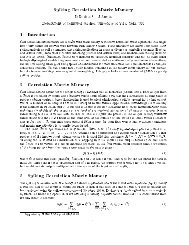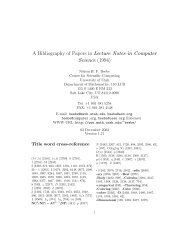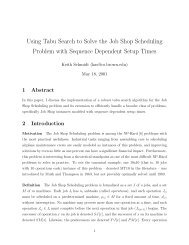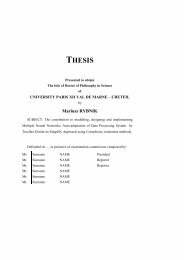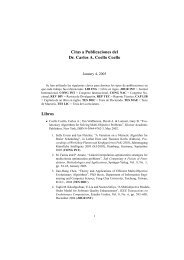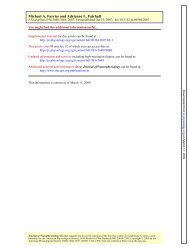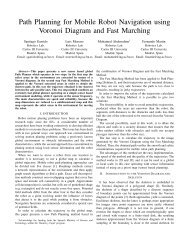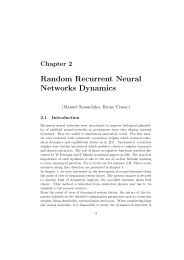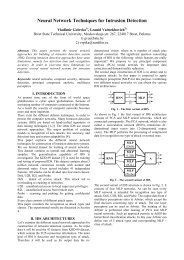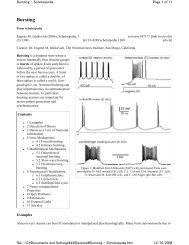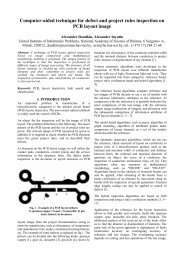Cross correlation function computation algorithm for video ...
Cross correlation function computation algorithm for video ...
Cross correlation function computation algorithm for video ...
Create successful ePaper yourself
Turn your PDF publications into a flip-book with our unique Google optimized e-Paper software.
<strong>Cross</strong> <strong>correlation</strong> <strong>function</strong> <strong>computation</strong> <strong>algorithm</strong> <strong>for</strong> <strong>video</strong><br />
surveillance system.<br />
Sadykhov R. Kh. 1,2) , Lamovsky D. V. 2)<br />
1) United Institute of In<strong>for</strong>matics Problems National Academy of Science of Belarus, The Laboratory<br />
of System Identification, 6, Surganov st., Minsk, 220012, Belarus, URL: http://lsi.bas-net.by<br />
2) Belarusian State University of In<strong>for</strong>matics and Radioelecrtonics, Computer Department, 6,<br />
P.Brovka st., Minsk, 220013, Belarus, E-mail: rsadykhov@bsuir.unibel.by, lamovsky@tut.by<br />
Abstract: This paper describes a new <strong>algorithm</strong> to<br />
calculate cross-<strong>correlation</strong> <strong>function</strong>. We combined box<br />
filtering technique <strong>for</strong> calculation of cross <strong>correlation</strong><br />
coefficients with parallel processing using MMX/SSE<br />
technology of modern general purpose processors. We<br />
have used this <strong>algorithm</strong> <strong>for</strong> real time optical flow<br />
estimation between frames of <strong>video</strong> sequence. Our<br />
<strong>algorithm</strong> was tested on real world <strong>video</strong> sequences<br />
obtained from the cameras of <strong>video</strong> surveillance system.<br />
Keywords: cross-<strong>correlation</strong>, fast <strong>algorithm</strong>, MMX/SSE<br />
extensions, optical flow, <strong>video</strong> surveillance system.<br />
1. INTRODUCTION<br />
Feature matching is an important task in the area of<br />
computer vision. There are several different approaches <strong>for</strong><br />
image correspondence estimation [1]. There is a group of<br />
so called area based methods [2] among them, and<br />
intensity values only are used to determine correspondence<br />
of the areas in this case. Three classes of metrics are<br />
commonly applied <strong>for</strong> area matching: cross <strong>correlation</strong><br />
(CC), intensity differences (sum of absolute differences<br />
(SAD), sum of squared differences (SSD)), and rank [3]<br />
metrics. <strong>Cross</strong> <strong>correlation</strong> metrics is the standard statistical<br />
method <strong>for</strong> determining of similarity. This metrics is more<br />
robust than the others but <strong>computation</strong>ally expensive.<br />
Feature matching is used in many problems of<br />
computer vision. One of them is optical flow estimation.<br />
Optical flow is a two-dimensional vector field that<br />
represents velocities and their directions in each point of<br />
the image. It is used in many applications such as robot<br />
navigation, object tracking, <strong>video</strong> coding, and scene<br />
reconstruction. There are several different approaches to<br />
determine optical flow [4, 5]. Correlation based methods<br />
give more accurate results in the case of noised images<br />
with non rigid objects. The real world scenes obtained<br />
from the cameras of <strong>video</strong> surveillance system correspond<br />
to these conditions.<br />
The main problem of most <strong>correlation</strong> based techniques<br />
is that they are <strong>computation</strong>ally expensive. This fact<br />
doesn’t allow using them in real time <strong>video</strong> processing.<br />
There are several ways to overcome this problem such as<br />
using optimal <strong>algorithm</strong>s, application of special purposes<br />
hardware or using SIMD extension of modern general<br />
purposes processors.<br />
Computationally optimal <strong>algorithm</strong>s implement<br />
different approaches which allow to reduce <strong>computation</strong>al<br />
cost <strong>for</strong> <strong>correlation</strong>. Fast Fourier trans<strong>for</strong>mation can be<br />
used <strong>for</strong> fast image matching <strong>algorithm</strong>s [1, 5], and such<br />
technique is exploited in [6]. Approach known as box<br />
filtering technique [7] is also used <strong>for</strong> fast <strong>correlation</strong><br />
calculation <strong>algorithm</strong>. Description of the <strong>algorithm</strong>s that<br />
compute SAD (sum of absolute differences) metrics using<br />
box filtering technique can be found in [8, 9]. This<br />
technique in [10, 11] is used <strong>for</strong> fast NCC (normalize<br />
cross-<strong>correlation</strong>) metrics.<br />
Using of special purposes hardware such as field<br />
programmable gate array (FPGA) chips is an excellent way<br />
to raise the per<strong>for</strong>mance of data processing. Several<br />
solutions can be discovered in [12, 13] <strong>for</strong> image and <strong>video</strong><br />
processing. Using such hardware can lead to acceptable<br />
results, but it also requires additional ef<strong>for</strong>ts <strong>for</strong> special<br />
<strong>computation</strong>al architecture realization.<br />
Modern general purposes processors have significant<br />
<strong>computation</strong>al power, moreover they have special sets of<br />
commands <strong>for</strong> accelerating multimedia and<br />
communication applications (we mean MMX and SSE<br />
extensions).<br />
MMX and SSE appeared accordingly in 1996 and 1999<br />
and since then all the popular general purposes processors<br />
support these technologies. These extensions exploits<br />
single instruction multiple data (SIMD) principle <strong>for</strong><br />
parallel data processing. MMX and SSE are sets of new<br />
processor commands and data types. MMX allows parallel<br />
processing of byte, word, double word integer values. The<br />
main disadvantage is that MMX registers are in fact FPU<br />
(floating point unit) registers with other names. It means<br />
that it isn’t possible to mix MMX instructions and FPU<br />
instructions in code. SSE is elaboration of MMX and<br />
operates with packed floating-point data. Also SSE<br />
includes 12 new instructions that extend the MMX<br />
instructions set and operate MMX registers. SSE2 is<br />
elaboration of both MMX and SSE. The key benefits of<br />
SSE2 are that MMX is extended to work with 128-bit data<br />
blocks, and the ability to support 64-bit floating-point<br />
values appeared.<br />
As shown in [14] using such extensions may be not so<br />
advantageous as special hardware, but it can assist to<br />
reduce significantly the time consumption in comparison<br />
with non MMX/SSE implementation. Examples of using<br />
MMX/SSE <strong>for</strong> digital image processing and evaluation of<br />
its productivity are presented in [15, 16, 17, 18].<br />
In our paper we use MMX/SSE technology <strong>for</strong><br />
developing fast box filtering technique based <strong>algorithm</strong> to<br />
per<strong>for</strong>m cross <strong>correlation</strong> calculation and employ this<br />
<strong>algorithm</strong> <strong>for</strong> real time optical flow estimation.<br />
2. FAST CROSS CORRELATION<br />
ALGORITHM<br />
The main aim of our paper was reduction of<br />
<strong>computation</strong>al costs <strong>for</strong> calculation cross <strong>correlation</strong><br />
<strong>function</strong>. First of all we choose <strong>computation</strong>ally optimal
method. Box filtering technique [7] is used in this method<br />
<strong>for</strong> fast cross <strong>correlation</strong> between frames.<br />
2.1. Box filtering technique<br />
Let f and g be normalized intensity’s of pixels on<br />
consecutive frames. <strong>Cross</strong> <strong>correlation</strong> between regions in<br />
these images can be calculated using:<br />
where<br />
cov<br />
covij,<br />
d ( f , g)<br />
xd<br />
y<br />
cij<br />
, dxd<br />
= , (1)<br />
y<br />
var ( f ) * var ( g)<br />
( f , g)<br />
=<br />
ij<br />
j+<br />
K / 2<br />
i+<br />
L/<br />
2<br />
∑ ∑<br />
ij,<br />
dxd<br />
y<br />
* g<br />
ij, dxd<br />
y<br />
n,<br />
m n+<br />
dx<br />
, m+<br />
d y<br />
m=<br />
j−K<br />
/ 2 n=<br />
i−L<br />
/ 2<br />
var<br />
var ( f ) =<br />
ij<br />
j+<br />
K / 2 i+<br />
L / 2<br />
2<br />
∑ ∑ fn,<br />
m<br />
m=<br />
j−K<br />
/ 2 n=<br />
i−L<br />
/ 2<br />
j+<br />
K / 2 i+<br />
L/<br />
2<br />
2<br />
ij, d d ( g)<br />
= ∑ ∑g<br />
x y<br />
n+<br />
dx<br />
, m+<br />
d y<br />
m=<br />
j−K<br />
/ 2 n=<br />
i−L<br />
/ 2<br />
f<br />
,(2)<br />
, (3)<br />
, (4)<br />
i, j – center of matching region on f; dx, dy – shift of<br />
matching region on g; K, L – matching region size.<br />
First and <strong>for</strong>emost we must per<strong>for</strong>m the normalization.<br />
It is essential <strong>for</strong> reduction of the influence of brightness<br />
and contrast changes between frames in cross-<strong>correlation</strong><br />
based methods. Computing the normalization in every<br />
<strong>correlation</strong> window requires an additional processing stage.<br />
We per<strong>for</strong>m it throughout the image instead of local <strong>for</strong><br />
every window. It is admissible because we process frames<br />
obtained with small time interval and when conditions may<br />
be changed with low probability.<br />
Equations (2), (3) and (4) are double sums and can be<br />
calculated using box filtering technique. They may be<br />
represented as:<br />
where<br />
Hsum<br />
ij<br />
=<br />
Vsum ( n)<br />
=<br />
j<br />
i+<br />
L / 2<br />
∑<br />
n=<br />
i−L<br />
/ 2<br />
Vsum ( n)<br />
, (5)<br />
j+<br />
K / 2<br />
∑ an,<br />
m *<br />
m=<br />
j−K<br />
/ 2<br />
j<br />
b<br />
n,<br />
m<br />
, (6)<br />
Vsumi(n) is the sum of products of pixel intensity<br />
values from column n of window with center in (i,j) on<br />
image a with respective values on image b.<br />
The main idea of the technique is that <strong>for</strong> calculation<br />
Vsumj(n) it is necessary to update Vsumj-1(n). This means<br />
to subtract multiplication of an,(j-K/2-1) and bn,(j-K/2-1) from it<br />
(leave sum because of shifting window) and to add<br />
multiplication of an,(j+K/2) and bn,(j+K/2) to it (enter the sum).<br />
For calculation Hsumij it is necessary to update the value of<br />
Hsum(i-1)j in the same way. Such method requires four<br />
addition-subtraction operations <strong>for</strong> new value calculation<br />
regardless of window size. The scheme of <strong>computation</strong> <strong>for</strong><br />
reviewed technique is presented in Fig. 1.<br />
The realization of the reviewed approach requires<br />
accurate calculation strategy. First of all it is necessary to<br />
exclude repeated calculation of the same value. For<br />
example, every value fm,n 2 is used at least two times: when<br />
it is added to the sum and when it is subtracted from it. We<br />
allocate special buffers in memory <strong>for</strong> such values.<br />
Our <strong>algorithm</strong> works with grayscale images. It requires<br />
byte per pixel in memory <strong>for</strong> frames. Intermediate values<br />
that have to be stored require double word per pixel<br />
because they are obtained by summation of multiplications<br />
of bytes. We assign memory <strong>for</strong> pairs of buffers to store<br />
products, intermediate sums and sought sums (3) and (4).<br />
We use pairs because the <strong>algorithm</strong> calculates (3) and (4)<br />
at one pass. Also we allocate memory <strong>for</strong> L*K buffers to<br />
store sought sums (2). In this case the <strong>algorithm</strong> does L*K<br />
passes in cycle to fill each buffer and uses previously<br />
allocated <strong>for</strong> calculation (3) buffers to store products and<br />
intermediate sums. There<strong>for</strong>e the <strong>algorithm</strong> requires<br />
N*M*(2*3+L*K) double words in memory <strong>for</strong> buffers.<br />
Fig. 1. Scheme of <strong>computation</strong>.<br />
2.2. Algorithm<br />
It is evident from Fig.1 that when Hsum is calculated in<br />
each pixel of the frame it is necessary to sum up L values<br />
of Vsum only once <strong>for</strong> every row. The calculation of Vsum<br />
requires summation of K products also only once <strong>for</strong> every<br />
column of the frame. This assertion leads to the next<br />
<strong>algorithm</strong> presented in pseudo code.<br />
For x=1 to number of columns do<br />
End<br />
Compute a*b <strong>for</strong> first K rows in column x<br />
(without using cycle).<br />
Compute Vsum in row 1 and column x by<br />
summation К values obtained previous step<br />
using (6).<br />
For y=2 to number of rows do<br />
For x=1 to number of columns do<br />
End<br />
Compute a*b in row y and column x.<br />
Compute Vsum updating previous value<br />
Vsum-1
End<br />
For y=1 to number of rows do<br />
End<br />
Compute Hsum in column 1 and row y by<br />
summation L values Vsum using (5).<br />
For x=2 to number of columns do<br />
End<br />
Compute Hsum updating previous value<br />
Hsum-1<br />
2.3. Correlation coefficients calculation<br />
using SIMD extensions.<br />
Te most <strong>computation</strong>aly expensive stage of cross<br />
<strong>correlation</strong> <strong>function</strong> calculation is computing of equation<br />
(1). It consists of three most complex operations:<br />
multiplication, division and square root <strong>computation</strong>. Fig.<br />
2 shows computing strategy <strong>for</strong> calculation of equation (1)<br />
with using SSE commands. Organization of data storage<br />
together with SIMD parallelism allows computing four<br />
values per one pass in cycle. We achieved the largest rising<br />
in per<strong>for</strong>mance exactly at this stage.<br />
Fig. 2. Computing strategy to calculate equation (1).<br />
2.4. Optical flow estimation.<br />
We implemented simple <strong>correlation</strong> based method to<br />
estimate optical flow, and applied cross <strong>correlation</strong> metrics<br />
<strong>for</strong> matching regions on consecutive frames of <strong>video</strong><br />
sequence. Our matching strategy uses <strong>correlation</strong> window<br />
to estimate correspondence of current pixel in surrounding<br />
area on previous frame. Optical flow in each point of frame<br />
is determined by maximum coefficient in sight area and<br />
size of this area depends on the size of the <strong>correlation</strong><br />
window.<br />
We realized the simple filter to reduce dynamic noise<br />
that appears because of discretization of analog <strong>video</strong><br />
image. Filtration is done by comparison difference of pixel<br />
intensity values on consecutive frames with threshold. The<br />
pixel value is changed when the mentioned difference<br />
exceeds defined value. We use this approach be<strong>for</strong>e<br />
<strong>correlation</strong> coefficients calculation to obtain more accurate<br />
result.<br />
3. RESULTS<br />
3.1. Experimental system<br />
All calculations described in this paper were<br />
per<strong>for</strong>med under FreeBSD 5.0 on a processor Pentium 4<br />
2.8 GHz with 512MB RDRAM. Per<strong>for</strong>mance evaluation<br />
was done with the frames obtained from analog <strong>video</strong><br />
camera of surveillance system. Discretization of analog<br />
<strong>video</strong> was carried out by frame grabber with BT-878 chip.<br />
It allows to obtain digital <strong>video</strong> sequences with maximum<br />
size 768x576 (PAL) or 640x480 (NTSC) and frequency 25<br />
fps.<br />
3.2. Per<strong>for</strong>mance<br />
The developed <strong>algorithm</strong> was employed <strong>for</strong> <strong>correlation</strong><br />
coefficients <strong>computation</strong> in images with size 320*240<br />
pixels. Computational cost of our <strong>algorithm</strong> in millions<br />
processor cycles is presented in Table 1. Correlation<br />
window size is 3*3 points in this case.<br />
Table 1. Computational cost in millions processor cycles <strong>for</strong><br />
C implementation and C/MMX/SSE implementation.<br />
Algorithm stage C<br />
C/<br />
MMX/<br />
SSE<br />
Profit<br />
Dynamic noise reduction 3.5 0.4 8.75<br />
Vsum <strong>computation</strong> <strong>for</strong> (3), (4) 4.4 2.8 1.57<br />
Hsum <strong>computation</strong> <strong>for</strong> (3), (4) 3.7 2.1 1.76<br />
Vsum <strong>computation</strong> <strong>for</strong> (2) 2.5 1.7 1.47<br />
Hsum <strong>computation</strong> <strong>for</strong> (2)<br />
Correlation coefficients<br />
2.1 1.1 1.9<br />
calculation and maximum<br />
coefficients determination<br />
284 16.7 17.6<br />
Total time consumptions <strong>for</strong> different window sizes are<br />
represented in Table 2.<br />
Table 2. Achieved time in ms. <strong>for</strong> C implementation and<br />
C/MMX/SSE implementation.<br />
Window size<br />
(L*K)<br />
Number of<br />
coefficients<br />
per pixel<br />
C<br />
C/<br />
MMX/SSE<br />
3*3 9 119 14<br />
5*5 25 379 42<br />
As evident from the results, increasing in per<strong>for</strong>mance<br />
does not depend on <strong>correlation</strong> window size. It is so<br />
because we use box filtering technique whose productivity<br />
is invariant from window size. Factor of productivity rising<br />
is approximately 8.5 times in both cases.<br />
To determine the accuracy of the developed <strong>algorithm</strong><br />
obtained coefficients were used <strong>for</strong> optical flow estimation<br />
according to the method described in section 2.4. Fig.3<br />
shows initial frames and obtained optical flow maps. These<br />
maps were obtained by using <strong>correlation</strong> window with size
3*3 pixels. Time consumptions <strong>for</strong> optical flow<br />
<strong>computation</strong> method are represented in Table 3.<br />
4. CONCLUSION<br />
We have developed fast <strong>algorithm</strong> to calculate cross<br />
<strong>correlation</strong> <strong>function</strong> with application MMX and SSE<br />
(SSE2) extensions of modern general purposes processors.<br />
Obtained results have shown high efficiency of such<br />
extensions in the field of computer vision. Our <strong>algorithm</strong><br />
can be used in other <strong>correlation</strong> based techniques such as<br />
stereo matching, feature detection, object tracking and<br />
others.<br />
Table 3. Achieved time in ms. <strong>for</strong> optical flow estimation.<br />
Frame size 3*3 5*5<br />
640*480 85 (10 fps) 159 (6 fps)<br />
320*240 19 (52 fps) 45 (22 fps)<br />
160*120 4 (250 fps) 7 (142 fps)<br />
We have used our <strong>algorithm</strong> <strong>for</strong> optical flow estimation.<br />
The experiments allow us to calculate optical flow between<br />
frames of <strong>video</strong> sequence in real time with high frame rate.<br />
Fig. 3. Optical flow estimation procedure result.<br />
5. REFERENCES<br />
[1] B. Zitova J. Flusser Image registration methods: a<br />
survey”, Image and Vision Computing, 21 (11) (2003). pp.<br />
977-1000<br />
[2] W. K. Pratt Correlation techniques of image<br />
registration, IEEE Transactions on Aerospace and<br />
Electronic Systems, 10 (1974). pp. 353–358.<br />
[3] R. Zabih J. Woodfill Non-Parametric Local<br />
Trans<strong>for</strong>ms <strong>for</strong> Computing Visual Correspondence,<br />
Proceedings 3rd European Conf. Computer Vision,<br />
Stockholm, 1994, pp. 150-158.<br />
[4] J. L. Barron D. J. Fleet S. S. Beauchemin<br />
Per<strong>for</strong>mance of optical flow techniques, International<br />
Journal of Computer Vision, 12(1) (1994), pp. 43-77.<br />
[5] S. S. Beauchemin J. L. Barron Computation of<br />
optical flow, ACM Computing Surveys, 27 (3) (1995). pp.<br />
433-467.<br />
[6] J. Weng. Image matching using the windowed<br />
Fourier phase International Journal of Computer Vision,<br />
11 (3) (1993). pp. 211-236.<br />
[7] M. J. McDonnel Box-filtering techniques, Computer<br />
Graphics and Image Processing, 17 (3) (1981). pp. 65-70.<br />
[8] H. Hirschmüller P. R. Innocent J. Garibaldi Real-time<br />
<strong>correlation</strong>-based stereo vision with reduced border errors,<br />
International Journal of Computer Vision, 47 (1-3) (2002).<br />
pp. 229 – 246.<br />
[9] K. Muhlmann D. Maier J. Hesser R. Manner<br />
Calculating dense disparity maps from color stereo images,<br />
an efficient implementation, International Journal of<br />
Computer Vision, 47 (1-3) (2002). pp. 79 – 88.<br />
[10] C. Sun Fast <strong>algorithm</strong>s <strong>for</strong> stereo matching and<br />
motion estimation, Proceedings of Australia-Japan<br />
Advanced Workshop on Computer Vision, Adelaide,<br />
Australia, September 2003, pp.38-48.<br />
[11] C. Sun Fast optical flow using 3d shortest path<br />
techniques, Image and vision computing, 20 (13/14)<br />
(2002). pp. 981-991.<br />
[12] J. Germano R. Baptista L. Sousa Configurable<br />
plat<strong>for</strong>m <strong>for</strong> real time <strong>video</strong> processing and vision systems,<br />
Proceedings of XX Conference on Design of Circuits and<br />
Integrated Systems (DCIS'05), Lisbonne, Portugal, 2005.<br />
[13] R.Andraka A dynamic hardware <strong>video</strong> processing<br />
plat<strong>for</strong>m, Proceedings of Conference on Reconfigurable<br />
Technology <strong>for</strong> Rapid Product Development and<br />
Computing,November 1996, pp. 90-99.<br />
[14] S. Persa P.P. Jonker Evaluation of two real time<br />
image processing architectures, Proceedings of 6th Annual<br />
Conf. of the Advanced School <strong>for</strong> Computing and Imaging<br />
(ASCI 2000), Lommel, Belgium, June 2000, pp. 387-392.<br />
[15] J. Skoglund M Felsberg Fast image processing using<br />
SSE2, Proceedings of the SSBA Symposium on Image<br />
Analysis, Malmö, March, 2005.<br />
[16] V. Kravtchenko Using MMX technology in digital<br />
image processing, Technical Report and Coding Examples<br />
TR-98-13, Department. of Computer Science. The<br />
University of British Columbia.<br />
[17] G. Conte S. Tommesani F. Zanichelli The long and<br />
winding road to high-per<strong>for</strong>mance image processing with<br />
MMX/SSE, Proceedings of the In Fifth IEEE International<br />
Workshop on Computer Architecture <strong>for</strong> Machine<br />
Perception, Padova, Italy, September 2000, p. 302.<br />
[18] L. Di Stefano S. Mattoccia Fast Stereo Matching <strong>for</strong><br />
the VIDET System using a General Purpose Processor<br />
with Multimedia Extensions, Proceedings of the In Fifth<br />
IEEE International Workshop on Computer Architecture<br />
<strong>for</strong> Machine Perception, Padova, Italy, September 2000.



